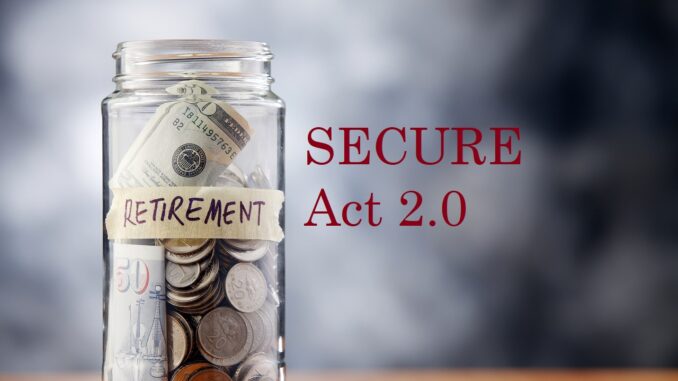
There is a reason for my question mark. SECURE Act 2.0 is complicated, to say the least. By my count, there are seven titles and 92 sections. The Senate finance committee has put out a section-by-section summary that is 19 pages long. Title III has the most sections, 50 in all, and is ironically titled, “Simplification and Clarification of Retirement Plan Rules”.
In true political fashion, those that made the original rules have now given us 50 more to “simplify” and “clarify” their previous rules. It figures.
Regardless, all sponsors and retirement plan service providers must continue to focus on the one and the only thing that matters…participant outcomes.
Therefore, the analysis of the practical application of SECURE Act 2.0 continues.
In the coming weeks we will look at the provisions for 2024 and beyond, but for now, here are a few more that are effective in 2023.
Employer Tax Credit for Military Spouse Eligibility
Generally, (no pun intended) military families move more frequently than non-military families. Spouses of military members may not be able to remain employed long enough to fully receive retirement plan benefits from employers who have long eligibility periods or vesting schedules.
SECURE Act 2.0 incentivizes employers with tax credits for shortening periods of eligibility and vesting schedules for military spouses. Small employers must include three features in their plan to qualify for the tax credit.
- Immediate eligibility within two months of hire.
- Immediately qualify for matching and non-elective contributions upon eligibility.
- Immediately 100% vested in employer contributions.
Self-Certifying Hardships
This provision is a carryover from the COVID-related distribution rules. In the past, employers were required to obtain documentation and further approve retirement plan hardship distributions. During the pandemic, employees could self-certify that they did not have other financial resources available for the purpose of hardship. Section 312 extends the ability to self-certify.
Taxes and penalties still apply to hardship distributions and plans that allow loans usually require participants to exhaust money available before requesting a hardship distribution. Employee education is key. Plan advisors play an important role in educating participants about their options.
ROTH Contributions for SIMPLE Plans.
Savings Incentive Match Plan for Employees, or SIMPLE IRA plans have been available for companies with 100 or fewer employees since the 1996 Small Business Job Protection Act. The acronym fits because these plans are “simple” to operate. There are no filing requirements, non-discrimination testing, detailed plan design, or high operating costs that usually accompany 401(k) plans.
The reason these plans are simple is that they are not flexible. Add flexibility and things get complicated, which is exactly what has happened by adding a ROTH component.
Although this provision is effective in 2023, the government may have gotten a bit ahead of itself with the start date. Even the IRS website, (as of February 15th, 2023) still says that “A SIMPLE IRA cannot be a Roth IRA.” I guess they didn’t get the memo.
The problem is that if tomorrow an employee asks to change their SIMPLE IRA contribution from pre-tax to Roth, that may not be possible with current payroll and IRA providers.
Providers of SIMPLE IRA accounts do not have the recordkeeping in place to separate Roth and pre-tax contributions. Also, employer contributions are currently pre-tax. Would employees need two separate accounts? One for Roth deferrals and one for employer contributions?
Does the provision for qualified plans that allows company matching and non-elective employer contributions to be received as Roth dollars apply to SIMPLE plans?
These are just a few of the adjustments that need guidance for SIMPLE plans to stay…well, simple.
2 Cents
Of the three provisions mentioned, helping military spouses receive benefits that they may not have been eligible for in the past, is certainly fair, and I am surprised it was not thought of earlier.
Regarding Roth contributions for SIMPLE plans and extending pandemic hardship distribution rules, the question remains if these provisions actually “enhance” retirement.
In my opinion, they fall into the category of more is less.
Final thoughts on SECURE Act 2.0 next week. After all, there are only 86 more sections to cover.
The opinions and commentary of the author are provided for general and educational purposes only and are not intended to provide legal, tax, or investment advice.
Information is as of the date published and may not contain updates or changes to the topics covered.
This information is not intended to reflect a current or past recommendation concerning investments, investment strategies, or account types; advice of any kind; or a solicitation of an offer to buy or sell any securities or investment services.
Wyatt Moerdyk is the CCO, and Managing Member of Evidence Advisors, LLC, a registered investment advisory firm.

